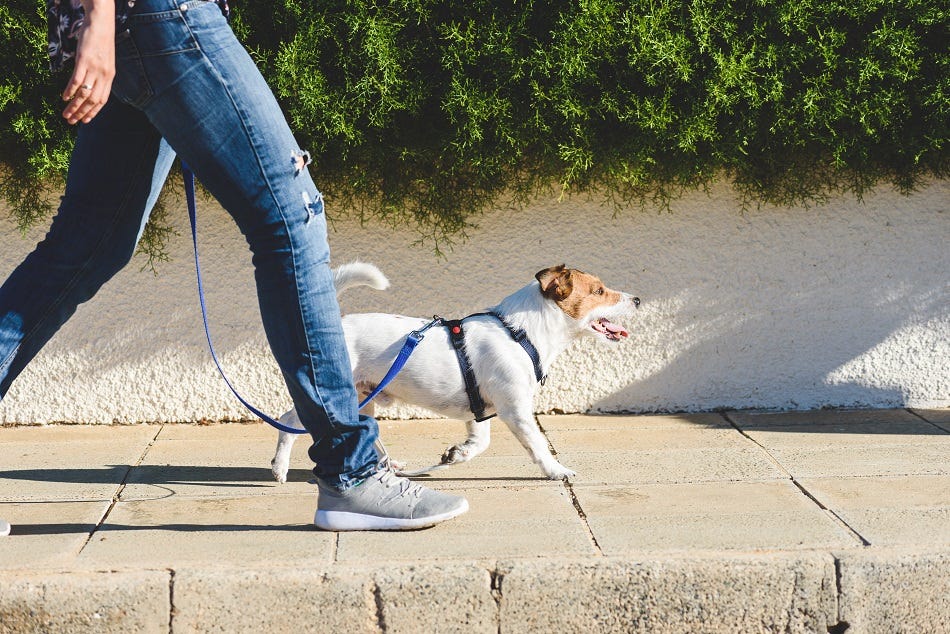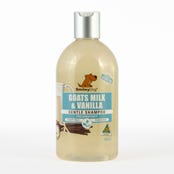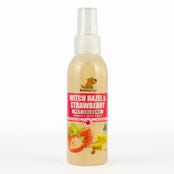There’s no quicker way to ruin a nice walk than with a pup that is pulling, or has managed to slip their collar and head for the nearest road. Especially at a young age, walking your puppy can feel like more of a workout for you, than them! To help walks go a little smoother, many owners are hanging up the collar and opting for a harness instead.
There are plenty of reasons why harnesses are preferred over collars. Harnesses are a safe and comfortable option for your pup, and offer control and loose-lead walking, without adding any pressure to their necks. Traditional collars can choke your pup when they pull. A harness, on the other hand, will distribute that weight across the chest – reducing the risk of choking. If you’ve heard the benefits, but aren’t sure where to start, this guide is for you! Keep reading to find out everything you need to know about choosing and fitting the right puppy harness and lead.
What is the best harness for a puppy?
Pups come in plenty of different shapes and sizes. That means the best harness for a puppy will depend on their breed. However, there are a few key things you’ll want to ask yourself:
- Is it adjustable? Will your pup have room to grow?
- Is the material soft enough for your pup? Will it also be tough enough that they can’t chew through it?
- Do you want a front clip or a back clip?
- Are you looking for a puppy training harness or a general walking harness?
- Does it have another purpose, such as restraining in the car?
Once you answer these questions, you can start looking for your harness. You may be after something with a specific purpose, like a puppy car harness, or a general walking harness. Once you’ve decided, make sure you measure your doggo before you order or buy. Some harnesses will be specific – like a harness for a small puppy – while others will go in weight ranges.
Take the following measurements to find the perfect harness fitting for your pup:
Chest: measure around your pup’s body, starting at the bottom of the rib cage before going up and over the back and then back to where you started.
Neck: measure around the thickest part of your dog’s neck. Don’t measure where they would usually wear their collar, as the top of his shoulders is narrower.
Weight: some harnesses will go in a weight range. You’ll want to make sure you get the right weight range otherwise a harness can easily snap.
Handy tip: if your pooch is between sizes, go for the slightly bigger one. You can always adjust the straps and give them plenty of room to grow.
How to put on a puppy harness?
With all the straps and buckles, learning how to fit a dog harness can be overwhelming to begin with – but it’s really quite simple! Different types of harnesses need to be put on in different ways. The two most common harnesses are overhead and step-in.
Overhead harness
A standard harness has one loop around the ribs and one loop around the neck, with a D-ring on the dog’s back to clip the leash. Here’s how to pop it on:
- Slide the harness over the head of your dog.
- Bring the chest piece up so it's touching their chest and belly.
- Fasten the buckles on either side of your dog, behind the front legs.
- Adjust the sides, belly and neck of the harness so they fit snug against your dog.
Step-in harness
- Lay the harness on the ground. The buckles should be on top of the D-rings.
- Hold your dog from behind and place his front feet into the two triangles.
- Pick up the two ends of the harness and clip them together.
- Make sure the harness is snug so that your dog can’t squeeze out.
Whether you have a small puppy harness or one for a larger breed, it’s always best to follow the instructions that come with your harness. For a complete guide on how to fit your pup, we have you covered!
If you still need a little extra helping hand, then head down to your closest store for all your dog harness fitting needs!
How do you know if you're not fitting a dog harness properly?
Not only can an ill-fitted harness cause your dog discomfort and pose a safety risk if they escape, but it can also cause medical problems. If your dog’s harness is too small and tight it can restrict their natural movements.
Sometimes it’s obvious that a harness isn’t fitting right. Other times, you may not pick up on it straight away. Here are some signs to be on the lookout for:
- Losing fur from rubbing around the harness area.
- Chafing around the harness.
- Your dog is able to wiggle free.
- The back of the harness rotates.
- Your dog refuses to walk or reacts negatively to you putting them on.
How to get a puppy used to harness?
It’s important to take the time to introduce your puppy to their harness. Like leash training, your pup will need to get used to walking on a harness. Creating a positive experience will make it easier for your dog to associate the harness with good things – like their favourite treat. Here are some tips to help:
- Get them used to the harness by putting it down on the floor so they can sniff it.
- Give your pup a treat and plenty of love when he shows interest in the harness.
- Pop them into the harness and let them wear it around the house for short periods of time.
- Once they’re comfortable, take them out to their favourite beach or doggy park so they associate the harness with a fun activity!
Puppy harness FAQs:
What is better for a puppy, collar or harness?
A collar that doesn’t constrict around the neck is fine for walking dogs that don’t pull or have respiratory issues. They are also more suitable for dogs to wear for a long period of time. A harness generally isn’t comfortable for all-day use. However, for dogs that are hard to walk, or pull, harnesses are a better option. They’re also great training tools for puppies to learn how to behave on a leash.
At what age can you put a harness on a puppy?
You can introduce your puppy to a harness at any age, ensuring the harness is the right fit for their quickly-growing bodies. However, the ideal age to introduce your pup to a harness is when you start to walk them, at around eight weeks.
Why does my puppy hate his harness?
There are many reasons why your pup might not like their harness, including:
- Their harness might not fit or just generally be uncomfortable.
- They don't like the harness material.
- They've made a negative association with wearing the harness.
- They don't like things going over their head.
























